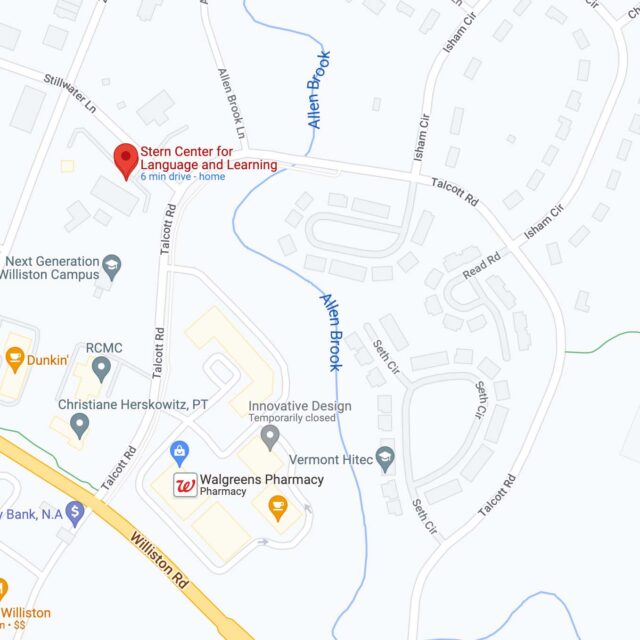
By Peggy Price, M.Ed., F/OGA, Director of the Stern Center Orton-Gillingham Institute and Leigh Buettler, M.Ed., Director of Professional Learning
Have you ever noticed that you can’t help but read words when you come across them? Whether we see text on a cereal box, a road sign, or the book cover, once we have become proficient readers, our brains can’t help but automatically read all the words we come across. That’s because skilled readers recognize words automatically – we have practiced to the point of mastery – and, as a result, our mental energies are freed up to do the work of thinking about what we read.
We want that same experience of automaticity for all our students. “Automaticity is defined as fast, accurate, and effortless word identification at the single word level…The speed and accuracy with which single words are identified is the best predictor of comprehension,” (Hook & Jones, 2002). To read effortlessly, our students need to be proficient in the foundational skills of automatic letter-sound correspondence and accurate phonemic awareness (Ashby, McBride, Naftel, O’Brien, Paulson, Kilpatrick, D. A, & Moats, 2023). The underlying skills for automaticity include automatic letter-sound correspondence and accurate phonemic awareness (Ashby, McBride, Naftel, O’Brien, Paulson, Kilpatrick, D. A, & Moats, 2023). Dr. David Kilpatrick (2020) explains that readers need more than letter-sound knowledge and phonemic awareness but letter-sound proficiency & phonemic proficiency (i.e., automaticity) for skilled word-level reading. Teaching to mastery is essential if our goal is word-level automaticity and reading comprehension.
As educators who provide literacy intervention, we want our students to be successful beyond the intervention setting. We want our students to be successful in other classes, content areas, and outside of school. For students to generalize information, our instruction needs to be both diagnostic and prescriptive: during lessons, we gather formal and informal data, provide efficient error correction, and then plan to use gathered data as the basis for designing the next lesson. By looking at student data, we can then determine whether students need continued instruction on a certain phonics pattern or skill. If so, they continue to receive targeted instruction to support their skill acquisition as they progress through a systematic and cumulative scope and sequence.
Well-designed intervention allows struggling readers to experience success with few errors to master a new skill. Through this practice, they will eventually be able to generalize this skill beyond the intervention setting. We increase the chance for student success when we create not only customized lessons, but lessons that are highly engaging with a high level of student-teacher interaction. A good lesson requires students to respond frequently and offer opportunities for elaboration, which makes the learning intellectually stimulating versus rote memorization. AsAnita Archer and Charles Hughes write in Explicit Instruction (2010, p. 6), “Merely engaging in a task or performing a skill is not useful if the percentage of errors is too high; in essence, students are spending time practicing their errors.” If we are designing lessons where our students have too many errors, we may be reinforcing their errors. We also need to be mindful of the pace at which we are moving through a scope and sequence, especially if we don’t have objective mastery criteria in place to tell us when it’s appropriate for the student to move on to the next skill. It may appear that the student is not responding to our instruction, when it may be that our instruction is not responding to student data.
We need to ask ourselves: What data, or mastery criteria, are we using to gauge whether a student has reached proficiency with a reading and spelling skill? How long should we practice and review a specific skill with a student? We must see student data, particularly their errors, as the student communicating to us what we need to teach and review. We know that without our support and guidance, our struggling students will be more error-prone. But establishing and utilizing mastery criteria can help mitigate this by ensuring the student is truly proficient in the skill. In this blog post, we share the objective mastery criteria used by the Stern Center Orton-Gillingham Institute.
We know there’s no one set of mastery criteria that everyone can adopt given diverse student needs, which is why we value coaching to help teachers consider their individual student(s) and classroom needs. With that in mind, you can see an example of mastery criteria below. This was developed by our OG Supervising Fellow, Shirley Bate, M.Ed. for students who need targeted reading intervention. Teachers who complete our OG for Intervention: Associate Level training learn how to apply these mastery criteria as part of their yearlong practicum or job-embedded coaching toward Orton-Gillingham certification.
Stern Center Orton-Gillingham Institute
Mastery Criteria within the OG Lesson:
OG for Intervention:
for 1:1-1:3 Intervention Setting*
1. Phonemic Awareness (PA) Mastery Criteria: 10 words are given
- Two consecutive lessons of 9/10 automatic utilizing David Kilpatrick’s Equipped for Reading Success.
- An example is the initial sound deletion of a consonant blend in a CCVC, such as “say sleep without /s/… leap.”
- Followed by Mixed Levels 9/10 automatic.
- Mixed Levels refers to practice with the specific PA skill the student just showed mastery criteria (e.g., initial sound deletion in a CCVC word) and review of earlier PA skills.
2. Words to Read (Word Work): No more than one error. Self-corrections count as errors.
3. Words to Spell (SOS): No more than one error. Self-corrections count as errors.
4. Oral Reading: The student reads at least 95%, ideally approximately 97-98% accuracy. Self-corrections count as errors. The lesson will often include both isolated sentences and a connected text. The connected text may be decodable or authentic depending on the student’s reading ability and the target skill of the lesson.
5. Sentence Dictation: All the words related to the lesson objective must be spelled correctly. Self-corrections do NOT count as errors if the student independently corrects their mistake as part of the proofreading process. *We apply different mastery criteria for whole class instruction within the general education setting, which you can learn more about in all our OG courses and two workshop series, Around the Block: Navigating OG and Your K-4 Literacy Block and Orton-Gillingham: Diagnostic Assessment Workshop Series.
You might be saying to yourself, “Wait, I thought self-corrections should be counted as correct!” However, as Drs. Ashby & Farrall (2020) wrote, “Remember that all miscues (repetitions, self-corrections, and synonyms) are the result of inaccuracies in decoding. These inaccuracies result in readers accessing the wrong word and interfere with building an accurate memory that will enable fast and accurate word recognition…. Dysfluent reading is usually a symptom of shaky decoding skills and weaknesses in phonological processing.” This article has been instrumental in our reevaluation of how to score self-corrections as errors against mastery criteria.
It can feel as though we are unfairly penalizing students for making an error or a self-correction. It is helpful to remember that a high bar for mastery criteria helps student generalize the skill beyond our intervention lessons and into their lives in and out of school.
This may sometimes mean a student needs more time and practice with a reading and spelling skill before moving onto a new concept in the scope and sequence. It is better to progress through the scope and sequence based on objective student data if it leads to better generalization. Otherwise, we may risk the student being retaught the same skills year after year, which can feel defeating. There is an old Orton-Gillingham adage by Margaret Byrd Rawson, past president of the National Orton Society (since renamed International Dyslexia Association) who said, “Teachers move as quickly as they can, go as slowly as they must.”
In sum, students who struggle to learn to read and write benefit from targeted intervention and instruction that have avery high bar for mastery. And remember that mastery does not mean 100%; there is always (at least a little) room for error!
References:
Hook, P. E., & Jones, S. D. (2002). The importance of automaticity and fluency for efficient reading comprehension. Perspectives, 28(1), 9-14.
Ashby, J., McBride, M., Naftel, S., O’Brien, E., Paulson, L. H., Kilpatrick, D. A., & Moats, L. C. (2023). Teaching Phoneme Awareness in 2023: A Guide for Educators. https://drive.google.com/drive/folders/1tPwupou7EqctDO50XtfvMGxfJAx7xPk9?usp=share_link
Kilpatrick, D. A. (2020). How the phonology of speech is foundational for instant word recognition. Perspectives on Language and Literacy, 46(3), 11-15. https://literacyhow.org/wp-content/uploads/2020/09/The-Phonology-of-Speech-in-WR-Kilpatrick.pdf
Archer, A. L., & Hughes, C. A. (2010). Explicit instruction: Effective and efficient teaching. Guilford Publications.
Ashby, J., Farrall, M. (2020). The Brain Basis of Fluency Development: Implications for Assessment and Instruction. OGA Winter/Spring Newsletter 2020. https://app.box.com/s/z4l3s3p0ap6t7n4z0c4y9b17ndgdz8ho
